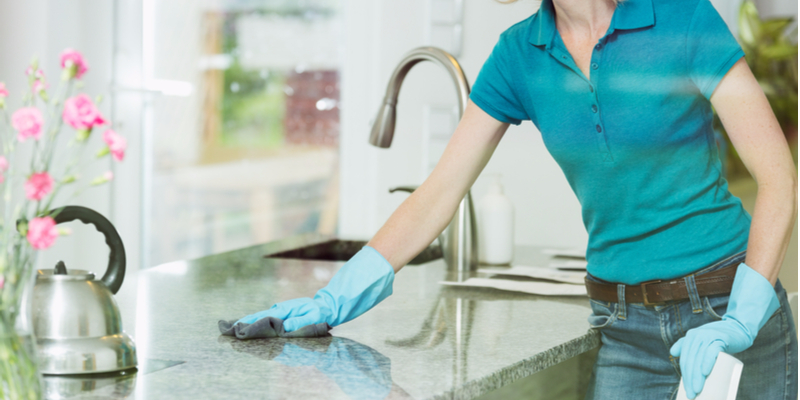Marble, always among the top selections for kitchens and bathrooms around the world, is a timeless choice whether your space is modern or classic. Marble’s subtle movement and veining means it is always distinct, without duplicate. While nearly everyone loves the look of marble, some shy away from choosing it for their project because they are fearful of cleaning and caring for it properly. Marble, as a natural stone, is porous and as such can be stained or scratched, especially when used in kitchen design. Yet the truth is, you can clean marble surfaces safely and keeping them looking beautiful for a long, long time. In most cases, marble is polished or honed. Polished marble is glossy and reflective, showing the unique hues and markings of the stone. Honed marble is like smooth satin and most often used as flooring.
Cleaning Your Marble
Keeping your marble surfaces clean is priority one to prevent not only staining but also scratching. Marble is susceptible to any acidic substances – lemon, alcohol, tomato – which can scratch or score the surface. This means whenever anything acidic is spilled, dripped, dropped, or splashed onto your marble, if you don’t wipe it up quickly, the acid will permanently mark your marble making it dull and dark.
This means you’ll want to avoid acidic cleaning solutions as well. Steer clear from cleaning solutions (commercial or homemade) with lemon juice, vinegar, or other acids, like bleach. Most spills and messes can be cleaned up easily with a mild soap and water. Wiping down your countertops with sudsy, warm water and a soft, non-abrasive cloth or sponge is the ideal cleaning method to prevent scratches and stains which can permeate and damage your marble.
Sealing, Protecting, and Restoring Your Marble
You can use a spray sealant on your marble monthly which helps prevent penetration and damage. Applying this type sealer allows you time to clean the spill before the stain is set in stone. Of course, there will be times when you won’t get to a spill in time and stains happen. For organic stains like tea, coffee, and foods, you can use a solution of hydrogen peroxide with a few drops ammonia to get rid of the stains. Oil-based stains (oils, makeup) require an application of household detergent, ammonia, soft liquid cleanser, or mineral spirits. Paint stains can be removed from marble using lacquer thinner or by scraping carefully with razor blade. For water spots or rings, buffing with #0000 steel wool will remove the stain. Rust can sometimes be removed with a special poultice, though often rust stains are permanent.
Stains on your marble caused by acidic substances are often accompanied by scratches (etches) in your marble. Once you’ve successfully removed the stain, you can attempt to restore the etched area by wetting the marble and applying marble polishing powder. Rubbing the powder with a damp cloth or using a buffing pad can make the etch mark disappear restore the surface shine. If the etch is deep, the marble will require honing to restore its natural appearance.
Cleaning Marble Floors
Marble floors should be cleaned regularly using a dust mop, followed by cleaning with a mild (phosphate free) dishwashing soap, or a soap stone. After washing, you’ll need to rinse the floor with clean water, and dry. Remember, you want to avoid cleaners with acid which will result in etching.
Cleaning Marble in Your Bathroom
Marble in the shower, should be squeegeed after each use, wiping away water as well as soap residue. Cleaning marble bathroom surfaces should be done with a mixture of ammonia and water or a non-acidic residue remover. Like in the kitchen, marble in the bathroom should be sealed for protection.

